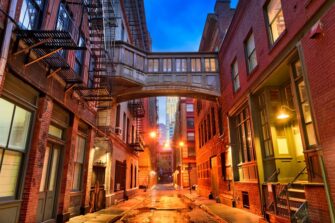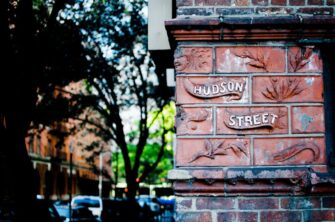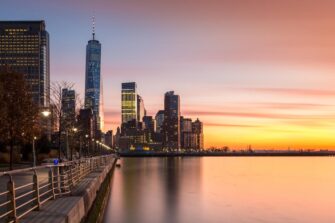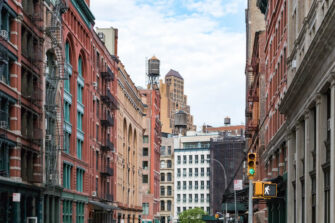Tribeca South Historic District Personal Injury Attorney

Located in Lower Manhattan, the Tribeca South Historic District has expanded since its initial establishment in 1992. Both portions now protect about 100 buildings of Italianate store-and-loft design built in the 1850s.
Key Features of the Area
Table of Contents
The entire neighborhood of Tribeca takes its name from “Triangle Below Canal Street,” even though this area on a map actually resembles a trapezoid. Tribeca is bounded by Canal Street, West Street, Broadway, and either Vesey, Chambers or Murray Streets. Originally farmland, it became a residential and later mercantile area in the 19th century, focusing on textiles, dry goods and produce.
Today Tribeca is known as one of Manhattan’s most chic and expensive neighborhoods, teeming with boutiques, art galleries, bars and restaurants. Its celebrity residents over the years include actor and producer Leonardo DiCaprio, artist Bill Barrett, actor and director Edward Burns, actor and comedian Billy Crystal, and singer/songwriter Beyoncé and her husband, rapper and entrepreneur Jay Z.
 Most of the buildings in the Tribeca South Historic District were erected before the Civil War. The Cary Building at 105 West Broadway is one such landmark. It stretches the length of Church Street between Chambers and Reade streets with cast-iron facades on each end by Architectural Iron Works. It once featured more than 1,500 goods that merchants would review and purchase for their stores.
Most of the buildings in the Tribeca South Historic District were erected before the Civil War. The Cary Building at 105 West Broadway is one such landmark. It stretches the length of Church Street between Chambers and Reade streets with cast-iron facades on each end by Architectural Iron Works. It once featured more than 1,500 goods that merchants would review and purchase for their stores.
William Henry Jones and his sister, Emily Jones, built two landmarks in the Tribeca South Historic District Extension. The building at 120 Chambers St. is one of the oldest surviving cast-iron buildings in New York City and an Italian Renaissance Revival companion to the Swift, Seaman & Co. building at 122 Chambers St.
Brief History of the Tribeca South Historic District

1812: Shipping hubs opening along what would come to be known as the Hudson River from theEast River lead to an influx of vendors in the area, then known as Washington Market.
1900 to 1920: The neighborhood becomes the center of the cotton and textile trade and a bustling commercial center, in part because of the city’s new subway lines.
1927: The Holland Tunnel opens, bringing more traffic in a vital connection between Manhattan and New Jersey.
1960s: Some of Tribeca’s commercial space empties as markets relocate, such as the produce market moving to Hunts Point in the Bronx.
1970s: As former warehouse buildings convert to residential use, artists find the loft space desirable. Legal papers first mention the “TriBeCa Artists’ Co-op,” leading to the name of the larger neighborhood.
1992: The Tribeca South Historic District is formally designated as such.
2002: The Tribeca South Historic District Extension is designated.
 Location
Location
The Tribeca South Historic District covers a little more than four blocks, stretching east from West Broadway to a bit past Church Street and south roughly from Thomas Street to Chambers Street. The Tribeca South Historic District Extension runs along a narrow portion between West Broadway and Church Street and stretching south from Chambers Street to Murray Street.
Interesting Facts About the Tribeca South Historic District
- The Tribeca South Historic District encompasses 70 buildings over roughly four blocks.
- The Tribeca South Historic District Extension encompasses 28 buildings, mostly five-story Italianate design, lending an attractive consistency to the area.
Directions to Belluck Law from the Tribeca South Historic District
Belluck Law mesothelioma cancer attorneys law office is located in Midtown Manhattan at 546 Fifth Ave., 5th Floor, New York NY 10036. From the Tribeca South Historic District and the Tribeca South Historic District Extension, head north on Church Street to Sixth Avenue. Keep heading north on Sixth Avenue, then turn right onto West 46th Street. Turn right onto Fifth Avenue to get to our service location.
Our office also is accessible by taking the 1, 2 or 3 subway train uptown from the Chambers Street station to Times Square/42nd Street and transferring to the 7 train to the Fifth Avenue/Bryant Park station.